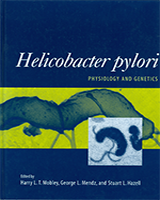From: Chapter 34, Adherence and Colonization

NCBI Bookshelf. A service of the National Library of Medicine, National Institutes of Health.

Overview of adherence phenotypes of H. pylori. H. pylori adheres to the host cell surface via bacterial adhesins interacting with host cell receptors (see Fig. 4). Following attachment, microvilli are denuded and tight junctions disrupted. Bacterial urease is at least partially responsible for tight junction disruption, but VacA may also be involved. It is not clear when mucus granules are depleted in relation to the other phenotypes, and at what stage rare H. pylori bacteria become internalized. Additionally, bacterial genes involved in the steps immediately after adherence are poorly understood, so it is not yet possible to block any of these steps so that they can be examined in more detail. The only genes implicated in any of the steps immediately after adherence are those in the cag pathogenicity island. In the model presented, translocation and tyrosine phosphorylation of CagA occurs after the pedestal formation, but it is also possible that this happens before pedestal formation.
From: Chapter 34, Adherence and Colonization

NCBI Bookshelf. A service of the National Library of Medicine, National Institutes of Health.